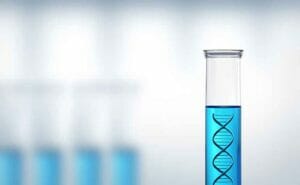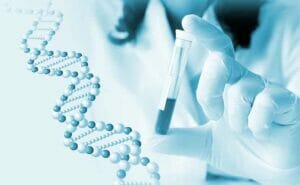Introduction
Chromosomal abnormalities refer to conditions where there are abnormalities in the number or structure of chromosomes, which house the genetic information (DNA) in humans. These abnormalities can lead to disturbances in the functioning of various genes, resulting in the emergence of symptoms. It is said to account for about 25% of congenital disorders, with Down syndrome being the most well-known chromosomal abnormality. You can read more about Down syndrome here.
Here, we will explain basic knowledge about chromosomes, the causes of chromosomal abnormalities, and the diseases and tests related to them.
What are Chromosomes?
Chromosomes are rod-shaped structures present in the “nucleus” of human cells, consisting of folded chains of DNA, which is the genetic information of humans. The number of chromosomes present in the nucleus varies among species; humans have 46 chromosomes, while mice have 38 and dogs have 78, for example.
Chromosomes come in pairs, with one inherited from the father and one from the mother, making a total of two for each type. So, in the case of humans, there are 23 pairs, totaling 46 chromosomes. Chromosomes are collections of genes, with each chromosome containing hundreds to thousands of genes.
Autosomes
Chromosomes are broadly categorized into sex chromosomes, which determine gender, and autosomes, which are all other chromosomes. In humans, sex chromosomes exist as one pair (two chromosomes), while autosomes exist as 22 pairs (44 chromosomes). Typically, chromosomes are named in order of length, starting with chromosome 1, chromosome 2, and so forth. (In reality, due to an error at the time of discovery, chromosome 21 is shorter than chromosome 22.)
Sex Chromosomes
In humans, the sex chromosomes that determine gender consist of two types: the X chromosome and the Y chromosome. Males have one X chromosome and one Y chromosome, while females have two X chromosomes.
Numerical Abnormalities of Chromosomes
Chromosomal abnormalities can be broadly categorized into numerical abnormalities and structural abnormalities. Numerical abnormalities occur when the number of chromosomes, which are normally in pairs, either increases to three or decreases to one. Down syndrome, which often results from having three copies of chromosome 21, is caused by a numerical abnormality of chromosomes. Down syndrome is caused by numerical abnormalities of chromosomes. Structural abnormalities, on the other hand, occur when the number of chromosomes is normal but there are missing, duplicated, or rearranged parts within the chromosomes, leading to abnormalities in gene function. Let’s first delve into numerical abnormalities in more detail.

Causes of Numerical Abnormalities of Chromosomes
In humans, during the process of cell division that occurs in the development of sperm and eggs, one of the 23 pairs of chromosomes is selected from each parent, resulting in half of the 23 pairs of chromosomes, a total of 23 chromosomes. This process is called “meiosis.” When fertilization occurs, the 23 chromosomes from the father and the 23 chromosomes from the mother combine again to form 46 chromosomes, which are then passed on to the child.
However, due to various reasons, one of the chromosomes may fail to separate properly, leading to both chromosomes ending up in either the sperm or the egg. This can result in abnormal sperm or eggs, a condition known as “chromosome non-disjunction.” When these abnormal sperm or eggs fertilize a normal egg or sperm, it can lead to the formation of a fertilized egg with either an extra chromosome (trisomy), having three copies of a particular chromosome, or with a missing chromosome (monosomy), having only one copy of a particular chromosome.
So, in summary, chromosome non-disjunction can result in either trisomy, where there are three copies of a chromosome, or monosomy, where there is only one copy of a chromosome.
The condition known as Down syndrome occurs when chromosome 21 becomes triplicated due to such causes, and it is believed that 90-95% of cases are caused by chromosomal nondisjunction. While there is known to be a relationship between chromosomal nondisjunction and advanced maternal age, the exact mechanisms are still not fully understood. Furthermore, although disorders resulting from numerical chromosomal abnormalities involve genes, chromosomal nondisjunction often occurs as a spontaneous mutation, with inheritance from parents being rare. Additionally, external factors such as stress during pregnancy do not typically cause chromosomal abnormalities.
Disorders Caused by Numerical Abnormalities of Chromosomes
Typical diseases caused by numerical chromosome abnormalities include
Autosomal numerical abnormalities
・Trisomy 21 (Down syndrome): This condition occurs when chromosome 21 becomes triplicated. It is the most common chromosomal abnormality disorder. Individuals with Down syndrome often have characteristic facial features such as low nasal bridge, small ears, and upward slanting eyes.
・Trisomy 13 (Patau syndrome): This condition occurs when chromosome 13 becomes triplicated. Characteristics may include cleft lip and palate, large nose, and small head.
・Trisomy 18 (Edwards syndrome): This condition occurs when chromosome 18 becomes triplicated. Characteristics may include prominent occiput, low-set ears, and small jaw.
Sex chromosome numerical abnormalities
・Turner syndrome: This condition occurs when there is only one X chromosome, making it the most common numerical chromosomal abnormality in females. Symptoms may include short stature, webbed neck, and amenorrhea.
・Klinefelter syndrome: This condition occurs when there are three sex chromosomes, X, X, and Y. It is a chromosomal abnormality commonly found in males and may present symptoms such as tall stature, gynecomastia, and impaired sperm function.
Structural Abnormalities of Chromosomes
In structural chromosomal abnormalities, the number of chromosomes remains normal, but there are alterations in the structure of one or more chromosomes. This can involve missing or extra segments of chromosomes, duplications, inversions, or translocations, leading to abnormalities in the functioning of genes.
Causes of Structural Abnormalities of Chromosomes
The causes of structural chromosomal abnormalities are primarily attributed to two main factors: de novo occurrences, which arise during the formation of sperm, eggs, or the fertilized egg, and inherited structural abnormalities passed down from both parents.
Common patterns of structural chromosomal abnormalities include deletion, where a portion of a chromosome is missing; duplication, where a portion of a chromosome is duplicated; and translocation, where segments of chromosomes are swapped between chromosomes.
Disorders Caused by Structural Abnormalities of Chromosomes
For diseases caused by structural abnormalities of chromosomes, please refer to the Hiro Clinic NIPT website: “Partial Deletions and Duplications: What Are Chromosomal Microdeletions and Microduplications?“
Inheritance of Structural Abnormalities of Chromosomes
Diseases caused by structural chromosomal abnormalities may have the potential to be inherited from both parents. If either parent carries a structural chromosomal abnormality, there’s a 50% chance it will be passed on to their child.
Chromosomal Abnormalities and Miscarriage
It’s believed that 50-70% of miscarriages are associated with chromosomal abnormalities. In cases where there are numerical chromosomal abnormalities, 75% of pregnancies typically end in miscarriage by the 8th week. For structural abnormalities, there are reports indicating a 10-20% chance of miscarriage.
Chromosomal Abnormalities Testing
To investigate chromosomal abnormalities, it’s essential to conduct tests both prenatally and postnatally to accurately diagnose the condition.

Types of Tests for Chromosomal Abnormalities
Quad Test
One blood test used to detect chromosomal abnormalities before birth is called the “Quad Test,” which measures four markers in the mother’s blood: β-hCG, unconjugated estriol, inhibin, and alpha-fetoprotein. While not covered by insurance, this test can be relatively inexpensive. However, its limitations include only addressing a limited number of conditions such as Down syndrome, Edwards syndrome (Trisomy 18), and open neural tube defects, and its diagnostic accuracy may not be high.
Amniocentesis
When chromosomal abnormalities are suspected through blood tests, amniocentesis is performed to confirm the diagnosis. This procedure involves using ultrasound to examine the fetus and the amniotic fluid, then inserting a thin needle to collect a sample of the amniotic fluid. The fetal cells present in the amniotic fluid are then examined.
Compared to blood tests, amniocentesis poses a greater physical burden on the body and carries a risk of miscarriage, occurring in a small percentage of about a few individuals per 1000. Additionally, there are risks of amniotic fluid leakage, uterine contractions, and infection.
What is NIPT (Non-Invasive Prenatal Testing)?
Recently, a test called Non-Invasive Prenatal Genetic Testing (NIPT) has also become available. This test, also known as “non-invasive prenatal genetic testing” when translated directly, is similar to the Quad Test in that it involves collecting blood from the mother. However, it is a new screening test that can analyze fragments of the baby’s DNA in the mother’s blood to examine chromosomal diseases and abnormalities. Compared to the Quad Test, this test has a higher reliability, but it is also costly and may not be covered by insurance. Additionally, some facilities may have criteria such as advanced maternal age for administering this test. At Hiro Clinic NIPT, it is possible to undergo this NIPT (Non-Invasive Prenatal Testing) as soon as pregnancy is confirmed through ultrasound.
None of these tests can provide a definitive diagnosis; they are merely screening tests. A definitive diagnosis requires amniocentesis.
Conclusion
Chromosomal abnormalities are divided into numerical abnormalities, where there is an abnormality in the number of chromosomes, and structural abnormalities, where there is an abnormality in part of the chromosome. Down syndrome is a representative disease of numerical abnormalities. Numerical abnormalities often result from mutations, while structural abnormalities may be inherited from both parents. Recently, a new test called NIPT (Non-Invasive Prenatal Testing), which can be performed using blood, has been introduced to examine these chromosomal abnormalities.
【References】
Japanese Association of Obstetricians and Gynecologists – Chromosomal Abnormalities
Article Editorial Supervisor

Dr. Keizo Nitta
Director, Hiro Clinic Sapporo Station Clinic
With the increasing trend of advanced maternal age at childbirth, the demand for NIPT (Non-Invasive Prenatal Testing) is on the rise. Moreover, we anticipate that in the future, the accuracy and scope of NIPT will continue to expand. At our clinic, we believe it is our obligation to appropriately communicate the information that can be known and desired in current medical practice to expectant mothers.
Alongside the right to know, there also exists the right not to know. We consider it a medical duty to refrain from disclosing information that the patient does not wish to know. At our clinic, you have the option to choose the information you want to know.
We encourage you to consult with us to determine which plan is best for you and to select the testing that suits your needs.
Career Summary
1996 Saitama Medical University Hospital
2002 Kanagawa Children’s Medical Center
2004 Kokumin Kyosai Yokohama Minami Kyosai Hospital
2010 Yokosuka Municipal Uwamachi Hospital
2012 Municipal Mikasa General Hospital
2015 Medical Corporation Ryokuryokai Nagunuma Pediatrics
2019 Town Minami Horo Hospital (National Health Insurance)
Qualifications
Member of the Allergy Society
Member of the Pediatric Allergy Society
 中文
中文























